Sustainable Construction Practices in India: An Overview
VerifiedAdded on 2023/06/03
|25
|8512
|54
Report
AI Summary
This report provides a comprehensive analysis of sustainable construction practices in India. It begins with an overview of the Indian construction industry, highlighting its growth and impact on natural resources. The report then delves into the current state of sustainable construction in India, including the adoption of green building practices and the role of various rating systems. It identifies factors hindering the adoption of sustainable construction, such as inadequate awareness, limited government policies, and a lack of skilled manpower. The report compares Indian construction practices with international standards, examining issues like waste management, alternative materials, and workforce skills. It also explores the importance of international exposure, the disadvantages of awarding contracts to foreign contractors, and methods used to promote sustainable construction in India, including awareness programs, training, and regulatory frameworks. The conclusion emphasizes the high prospects for sustainable construction in India and the need for government support and proper regulatory structures.
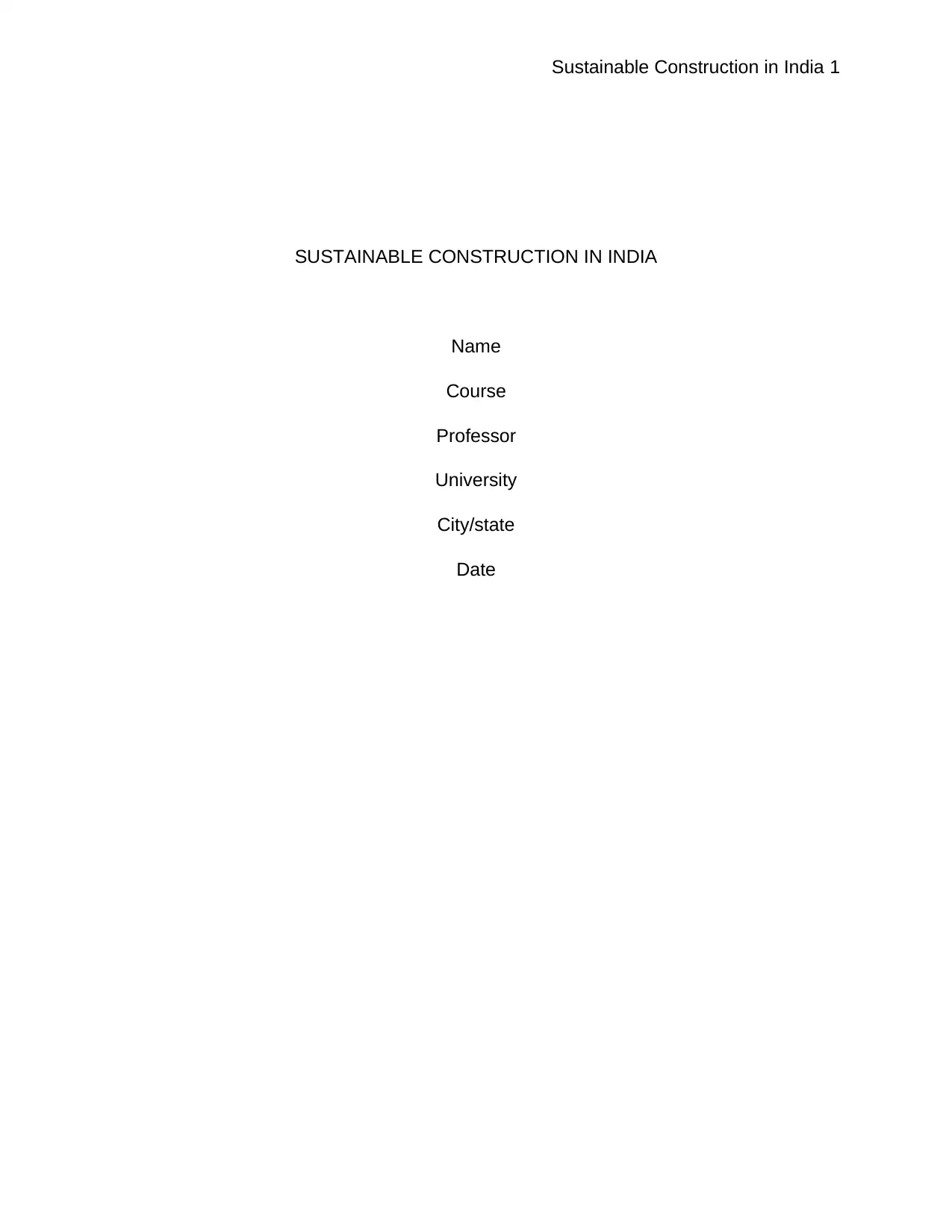
Sustainable Construction in India 1
SUSTAINABLE CONSTRUCTION IN INDIA
Name
Course
Professor
University
City/state
Date
SUSTAINABLE CONSTRUCTION IN INDIA
Name
Course
Professor
University
City/state
Date
Paraphrase This Document
Need a fresh take? Get an instant paraphrase of this document with our AI Paraphraser
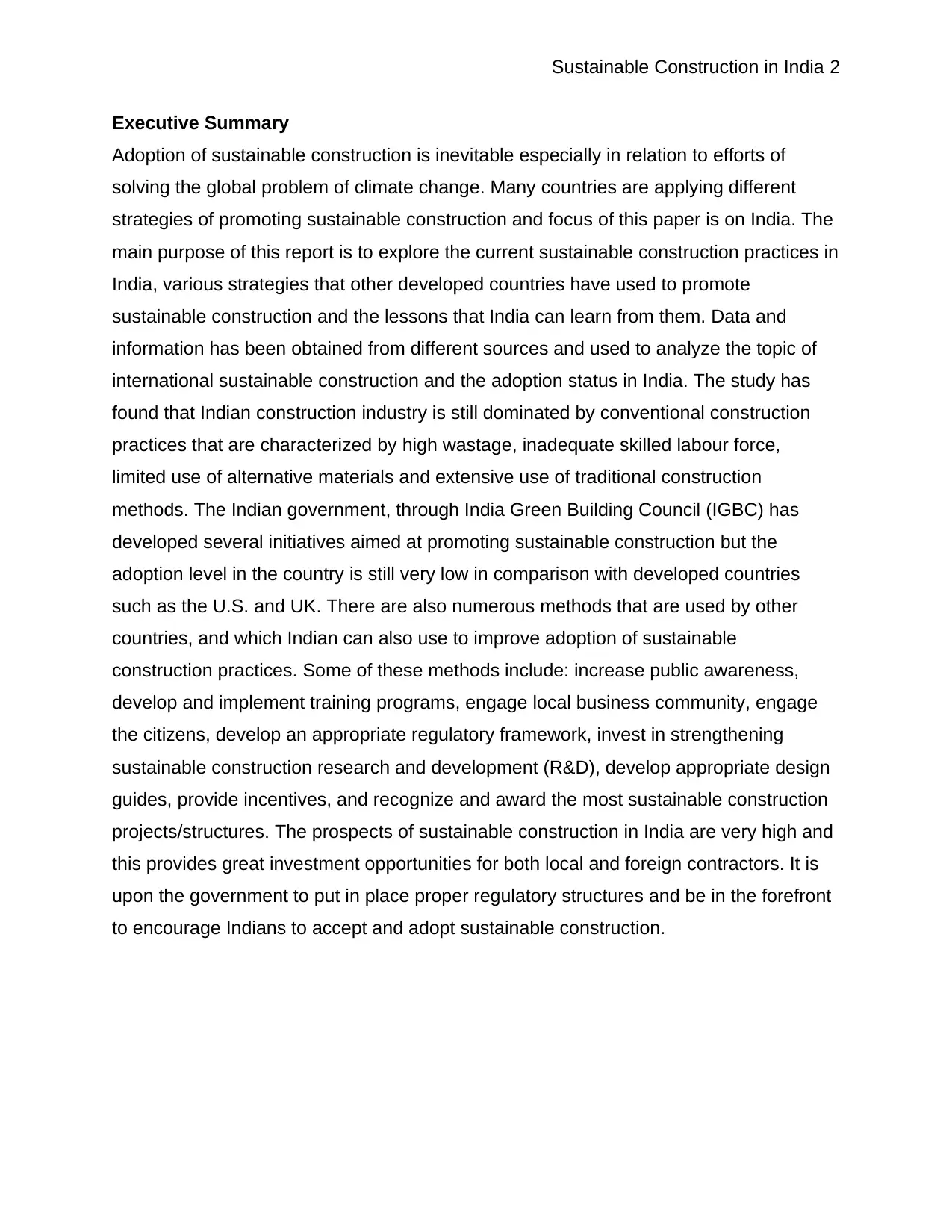
Sustainable Construction in India 2
Executive Summary
Adoption of sustainable construction is inevitable especially in relation to efforts of
solving the global problem of climate change. Many countries are applying different
strategies of promoting sustainable construction and focus of this paper is on India. The
main purpose of this report is to explore the current sustainable construction practices in
India, various strategies that other developed countries have used to promote
sustainable construction and the lessons that India can learn from them. Data and
information has been obtained from different sources and used to analyze the topic of
international sustainable construction and the adoption status in India. The study has
found that Indian construction industry is still dominated by conventional construction
practices that are characterized by high wastage, inadequate skilled labour force,
limited use of alternative materials and extensive use of traditional construction
methods. The Indian government, through India Green Building Council (IGBC) has
developed several initiatives aimed at promoting sustainable construction but the
adoption level in the country is still very low in comparison with developed countries
such as the U.S. and UK. There are also numerous methods that are used by other
countries, and which Indian can also use to improve adoption of sustainable
construction practices. Some of these methods include: increase public awareness,
develop and implement training programs, engage local business community, engage
the citizens, develop an appropriate regulatory framework, invest in strengthening
sustainable construction research and development (R&D), develop appropriate design
guides, provide incentives, and recognize and award the most sustainable construction
projects/structures. The prospects of sustainable construction in India are very high and
this provides great investment opportunities for both local and foreign contractors. It is
upon the government to put in place proper regulatory structures and be in the forefront
to encourage Indians to accept and adopt sustainable construction.
Executive Summary
Adoption of sustainable construction is inevitable especially in relation to efforts of
solving the global problem of climate change. Many countries are applying different
strategies of promoting sustainable construction and focus of this paper is on India. The
main purpose of this report is to explore the current sustainable construction practices in
India, various strategies that other developed countries have used to promote
sustainable construction and the lessons that India can learn from them. Data and
information has been obtained from different sources and used to analyze the topic of
international sustainable construction and the adoption status in India. The study has
found that Indian construction industry is still dominated by conventional construction
practices that are characterized by high wastage, inadequate skilled labour force,
limited use of alternative materials and extensive use of traditional construction
methods. The Indian government, through India Green Building Council (IGBC) has
developed several initiatives aimed at promoting sustainable construction but the
adoption level in the country is still very low in comparison with developed countries
such as the U.S. and UK. There are also numerous methods that are used by other
countries, and which Indian can also use to improve adoption of sustainable
construction practices. Some of these methods include: increase public awareness,
develop and implement training programs, engage local business community, engage
the citizens, develop an appropriate regulatory framework, invest in strengthening
sustainable construction research and development (R&D), develop appropriate design
guides, provide incentives, and recognize and award the most sustainable construction
projects/structures. The prospects of sustainable construction in India are very high and
this provides great investment opportunities for both local and foreign contractors. It is
upon the government to put in place proper regulatory structures and be in the forefront
to encourage Indians to accept and adopt sustainable construction.
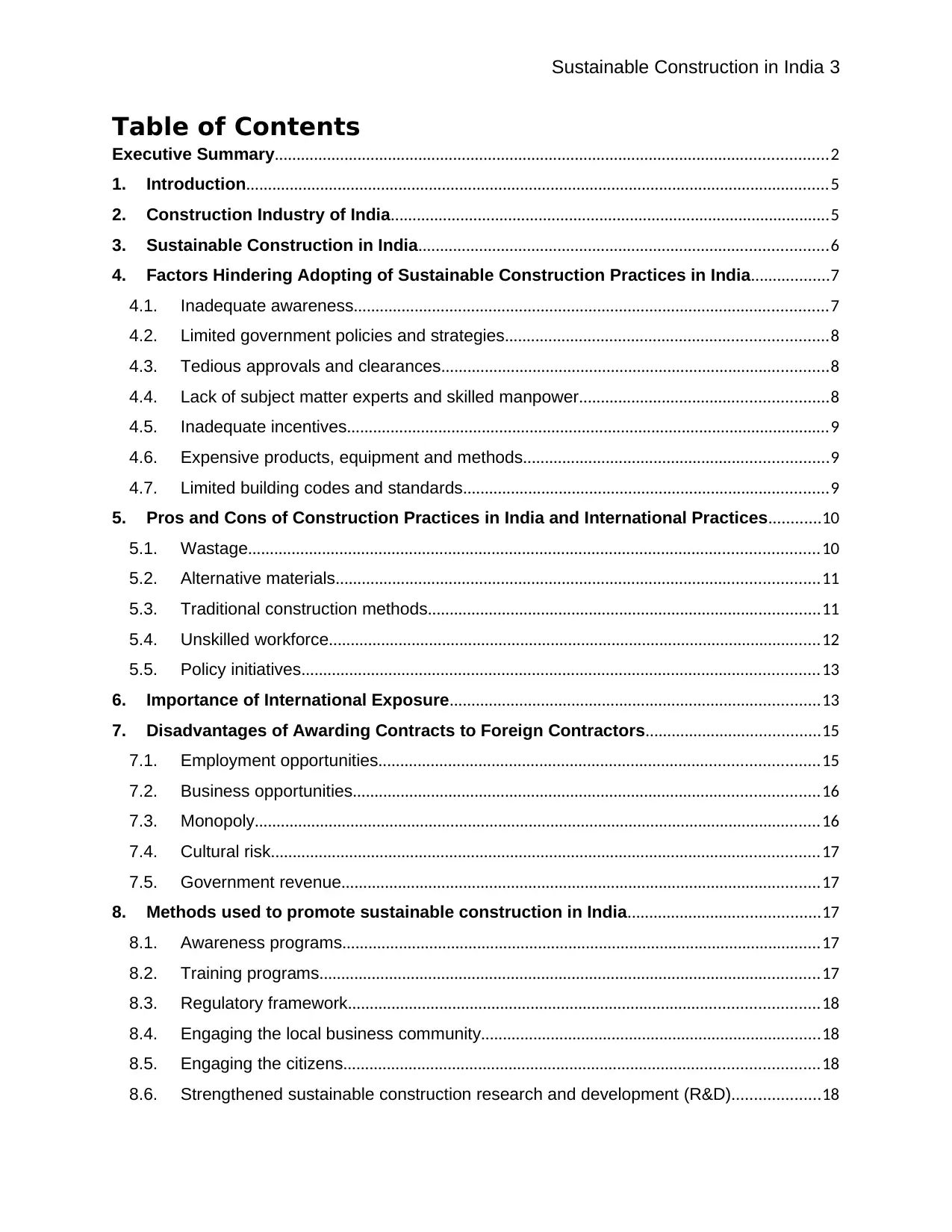
Sustainable Construction in India 3
Table of Contents
Executive Summary...............................................................................................................................2
1. Introduction......................................................................................................................................5
2. Construction Industry of India.....................................................................................................5
3. Sustainable Construction in India..............................................................................................6
4. Factors Hindering Adopting of Sustainable Construction Practices in India..................7
4.1. Inadequate awareness.............................................................................................................7
4.2. Limited government policies and strategies..........................................................................8
4.3. Tedious approvals and clearances.........................................................................................8
4.4. Lack of subject matter experts and skilled manpower.........................................................8
4.5. Inadequate incentives...............................................................................................................9
4.6. Expensive products, equipment and methods......................................................................9
4.7. Limited building codes and standards....................................................................................9
5. Pros and Cons of Construction Practices in India and International Practices............10
5.1. Wastage...................................................................................................................................10
5.2. Alternative materials...............................................................................................................11
5.3. Traditional construction methods..........................................................................................11
5.4. Unskilled workforce.................................................................................................................12
5.5. Policy initiatives.......................................................................................................................13
6. Importance of International Exposure.....................................................................................13
7. Disadvantages of Awarding Contracts to Foreign Contractors........................................15
7.1. Employment opportunities.....................................................................................................15
7.2. Business opportunities...........................................................................................................16
7.3. Monopoly..................................................................................................................................16
7.4. Cultural risk..............................................................................................................................17
7.5. Government revenue..............................................................................................................17
8. Methods used to promote sustainable construction in India............................................17
8.1. Awareness programs..............................................................................................................17
8.2. Training programs...................................................................................................................17
8.3. Regulatory framework............................................................................................................18
8.4. Engaging the local business community..............................................................................18
8.5. Engaging the citizens.............................................................................................................18
8.6. Strengthened sustainable construction research and development (R&D)....................18
Table of Contents
Executive Summary...............................................................................................................................2
1. Introduction......................................................................................................................................5
2. Construction Industry of India.....................................................................................................5
3. Sustainable Construction in India..............................................................................................6
4. Factors Hindering Adopting of Sustainable Construction Practices in India..................7
4.1. Inadequate awareness.............................................................................................................7
4.2. Limited government policies and strategies..........................................................................8
4.3. Tedious approvals and clearances.........................................................................................8
4.4. Lack of subject matter experts and skilled manpower.........................................................8
4.5. Inadequate incentives...............................................................................................................9
4.6. Expensive products, equipment and methods......................................................................9
4.7. Limited building codes and standards....................................................................................9
5. Pros and Cons of Construction Practices in India and International Practices............10
5.1. Wastage...................................................................................................................................10
5.2. Alternative materials...............................................................................................................11
5.3. Traditional construction methods..........................................................................................11
5.4. Unskilled workforce.................................................................................................................12
5.5. Policy initiatives.......................................................................................................................13
6. Importance of International Exposure.....................................................................................13
7. Disadvantages of Awarding Contracts to Foreign Contractors........................................15
7.1. Employment opportunities.....................................................................................................15
7.2. Business opportunities...........................................................................................................16
7.3. Monopoly..................................................................................................................................16
7.4. Cultural risk..............................................................................................................................17
7.5. Government revenue..............................................................................................................17
8. Methods used to promote sustainable construction in India............................................17
8.1. Awareness programs..............................................................................................................17
8.2. Training programs...................................................................................................................17
8.3. Regulatory framework............................................................................................................18
8.4. Engaging the local business community..............................................................................18
8.5. Engaging the citizens.............................................................................................................18
8.6. Strengthened sustainable construction research and development (R&D)....................18
⊘ This is a preview!⊘
Do you want full access?
Subscribe today to unlock all pages.

Trusted by 1+ million students worldwide

Sustainable Construction in India 4
8.7. Design guides..........................................................................................................................19
8.8. Incentives.................................................................................................................................19
8.9. Recognition and awards.........................................................................................................19
9. Conclusion.....................................................................................................................................20
References................................................................................................................................................22
8.7. Design guides..........................................................................................................................19
8.8. Incentives.................................................................................................................................19
8.9. Recognition and awards.........................................................................................................19
9. Conclusion.....................................................................................................................................20
References................................................................................................................................................22
Paraphrase This Document
Need a fresh take? Get an instant paraphrase of this document with our AI Paraphraser
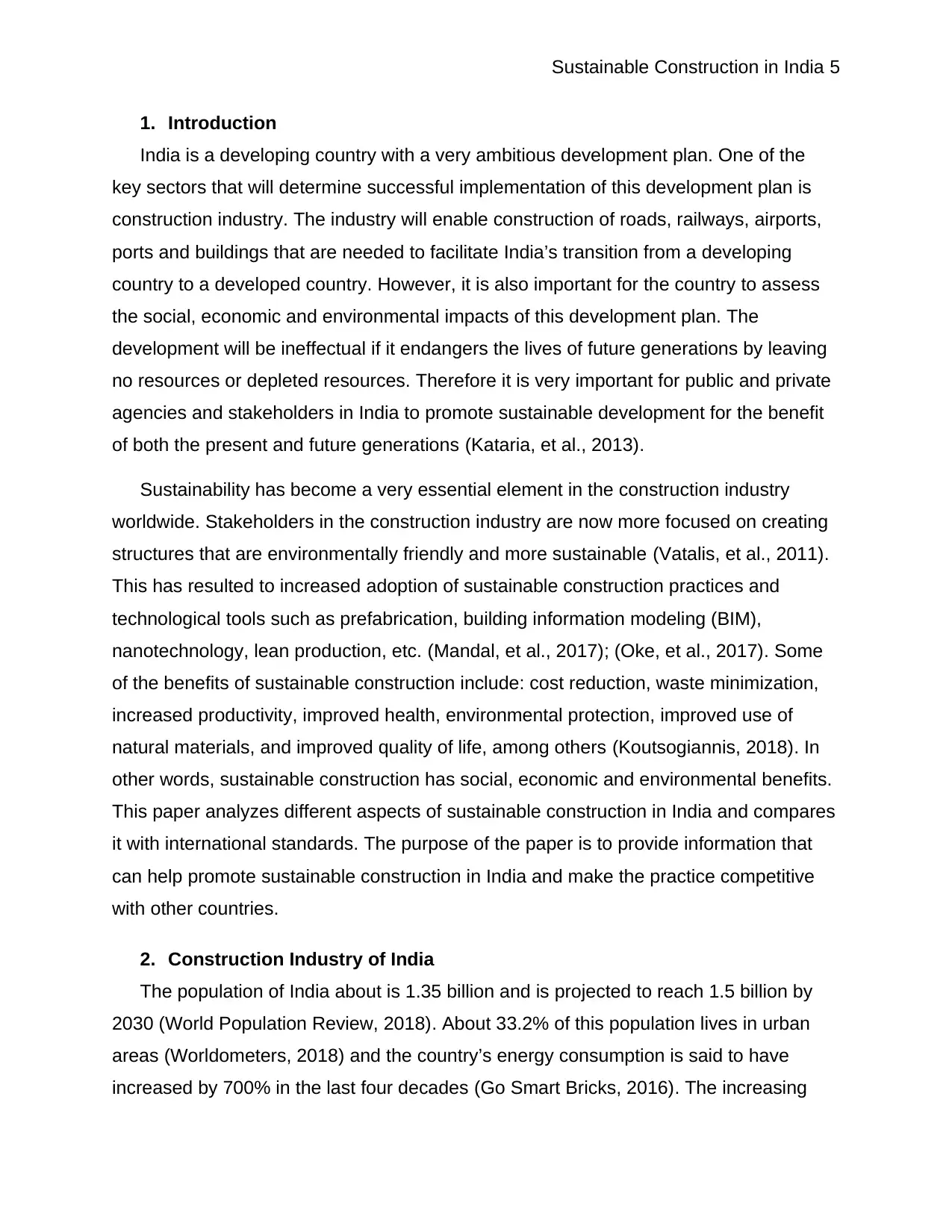
Sustainable Construction in India 5
1. Introduction
India is a developing country with a very ambitious development plan. One of the
key sectors that will determine successful implementation of this development plan is
construction industry. The industry will enable construction of roads, railways, airports,
ports and buildings that are needed to facilitate India’s transition from a developing
country to a developed country. However, it is also important for the country to assess
the social, economic and environmental impacts of this development plan. The
development will be ineffectual if it endangers the lives of future generations by leaving
no resources or depleted resources. Therefore it is very important for public and private
agencies and stakeholders in India to promote sustainable development for the benefit
of both the present and future generations (Kataria, et al., 2013).
Sustainability has become a very essential element in the construction industry
worldwide. Stakeholders in the construction industry are now more focused on creating
structures that are environmentally friendly and more sustainable (Vatalis, et al., 2011).
This has resulted to increased adoption of sustainable construction practices and
technological tools such as prefabrication, building information modeling (BIM),
nanotechnology, lean production, etc. (Mandal, et al., 2017); (Oke, et al., 2017). Some
of the benefits of sustainable construction include: cost reduction, waste minimization,
increased productivity, improved health, environmental protection, improved use of
natural materials, and improved quality of life, among others (Koutsogiannis, 2018). In
other words, sustainable construction has social, economic and environmental benefits.
This paper analyzes different aspects of sustainable construction in India and compares
it with international standards. The purpose of the paper is to provide information that
can help promote sustainable construction in India and make the practice competitive
with other countries.
2. Construction Industry of India
The population of India about is 1.35 billion and is projected to reach 1.5 billion by
2030 (World Population Review, 2018). About 33.2% of this population lives in urban
areas (Worldometers, 2018) and the country’s energy consumption is said to have
increased by 700% in the last four decades (Go Smart Bricks, 2016). The increasing
1. Introduction
India is a developing country with a very ambitious development plan. One of the
key sectors that will determine successful implementation of this development plan is
construction industry. The industry will enable construction of roads, railways, airports,
ports and buildings that are needed to facilitate India’s transition from a developing
country to a developed country. However, it is also important for the country to assess
the social, economic and environmental impacts of this development plan. The
development will be ineffectual if it endangers the lives of future generations by leaving
no resources or depleted resources. Therefore it is very important for public and private
agencies and stakeholders in India to promote sustainable development for the benefit
of both the present and future generations (Kataria, et al., 2013).
Sustainability has become a very essential element in the construction industry
worldwide. Stakeholders in the construction industry are now more focused on creating
structures that are environmentally friendly and more sustainable (Vatalis, et al., 2011).
This has resulted to increased adoption of sustainable construction practices and
technological tools such as prefabrication, building information modeling (BIM),
nanotechnology, lean production, etc. (Mandal, et al., 2017); (Oke, et al., 2017). Some
of the benefits of sustainable construction include: cost reduction, waste minimization,
increased productivity, improved health, environmental protection, improved use of
natural materials, and improved quality of life, among others (Koutsogiannis, 2018). In
other words, sustainable construction has social, economic and environmental benefits.
This paper analyzes different aspects of sustainable construction in India and compares
it with international standards. The purpose of the paper is to provide information that
can help promote sustainable construction in India and make the practice competitive
with other countries.
2. Construction Industry of India
The population of India about is 1.35 billion and is projected to reach 1.5 billion by
2030 (World Population Review, 2018). About 33.2% of this population lives in urban
areas (Worldometers, 2018) and the country’s energy consumption is said to have
increased by 700% in the last four decades (Go Smart Bricks, 2016). The increasing
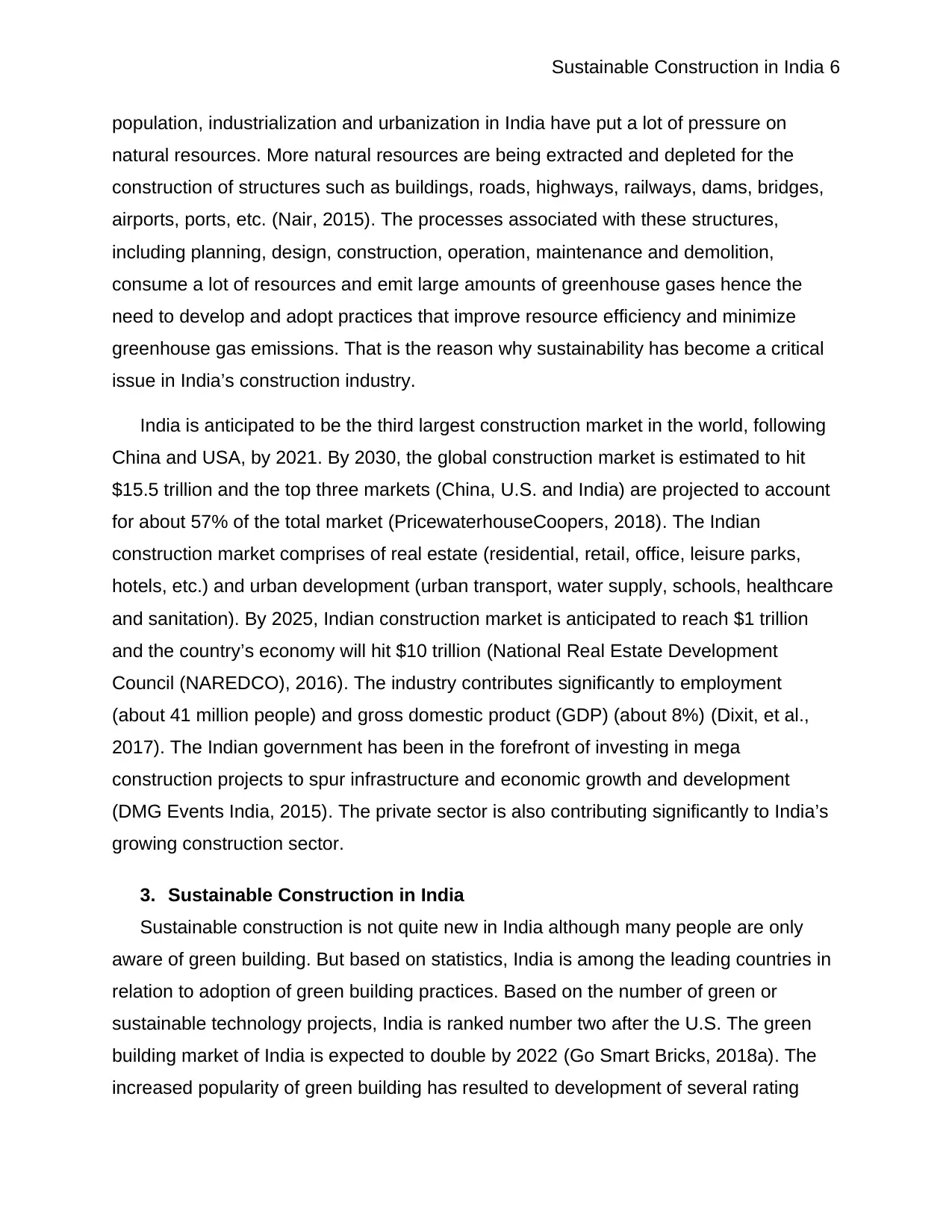
Sustainable Construction in India 6
population, industrialization and urbanization in India have put a lot of pressure on
natural resources. More natural resources are being extracted and depleted for the
construction of structures such as buildings, roads, highways, railways, dams, bridges,
airports, ports, etc. (Nair, 2015). The processes associated with these structures,
including planning, design, construction, operation, maintenance and demolition,
consume a lot of resources and emit large amounts of greenhouse gases hence the
need to develop and adopt practices that improve resource efficiency and minimize
greenhouse gas emissions. That is the reason why sustainability has become a critical
issue in India’s construction industry.
India is anticipated to be the third largest construction market in the world, following
China and USA, by 2021. By 2030, the global construction market is estimated to hit
$15.5 trillion and the top three markets (China, U.S. and India) are projected to account
for about 57% of the total market (PricewaterhouseCoopers, 2018). The Indian
construction market comprises of real estate (residential, retail, office, leisure parks,
hotels, etc.) and urban development (urban transport, water supply, schools, healthcare
and sanitation). By 2025, Indian construction market is anticipated to reach $1 trillion
and the country’s economy will hit $10 trillion (National Real Estate Development
Council (NAREDCO), 2016). The industry contributes significantly to employment
(about 41 million people) and gross domestic product (GDP) (about 8%) (Dixit, et al.,
2017). The Indian government has been in the forefront of investing in mega
construction projects to spur infrastructure and economic growth and development
(DMG Events India, 2015). The private sector is also contributing significantly to India’s
growing construction sector.
3. Sustainable Construction in India
Sustainable construction is not quite new in India although many people are only
aware of green building. But based on statistics, India is among the leading countries in
relation to adoption of green building practices. Based on the number of green or
sustainable technology projects, India is ranked number two after the U.S. The green
building market of India is expected to double by 2022 (Go Smart Bricks, 2018a). The
increased popularity of green building has resulted to development of several rating
population, industrialization and urbanization in India have put a lot of pressure on
natural resources. More natural resources are being extracted and depleted for the
construction of structures such as buildings, roads, highways, railways, dams, bridges,
airports, ports, etc. (Nair, 2015). The processes associated with these structures,
including planning, design, construction, operation, maintenance and demolition,
consume a lot of resources and emit large amounts of greenhouse gases hence the
need to develop and adopt practices that improve resource efficiency and minimize
greenhouse gas emissions. That is the reason why sustainability has become a critical
issue in India’s construction industry.
India is anticipated to be the third largest construction market in the world, following
China and USA, by 2021. By 2030, the global construction market is estimated to hit
$15.5 trillion and the top three markets (China, U.S. and India) are projected to account
for about 57% of the total market (PricewaterhouseCoopers, 2018). The Indian
construction market comprises of real estate (residential, retail, office, leisure parks,
hotels, etc.) and urban development (urban transport, water supply, schools, healthcare
and sanitation). By 2025, Indian construction market is anticipated to reach $1 trillion
and the country’s economy will hit $10 trillion (National Real Estate Development
Council (NAREDCO), 2016). The industry contributes significantly to employment
(about 41 million people) and gross domestic product (GDP) (about 8%) (Dixit, et al.,
2017). The Indian government has been in the forefront of investing in mega
construction projects to spur infrastructure and economic growth and development
(DMG Events India, 2015). The private sector is also contributing significantly to India’s
growing construction sector.
3. Sustainable Construction in India
Sustainable construction is not quite new in India although many people are only
aware of green building. But based on statistics, India is among the leading countries in
relation to adoption of green building practices. Based on the number of green or
sustainable technology projects, India is ranked number two after the U.S. The green
building market of India is expected to double by 2022 (Go Smart Bricks, 2018a). The
increased popularity of green building has resulted to development of several rating
⊘ This is a preview!⊘
Do you want full access?
Subscribe today to unlock all pages.

Trusted by 1+ million students worldwide
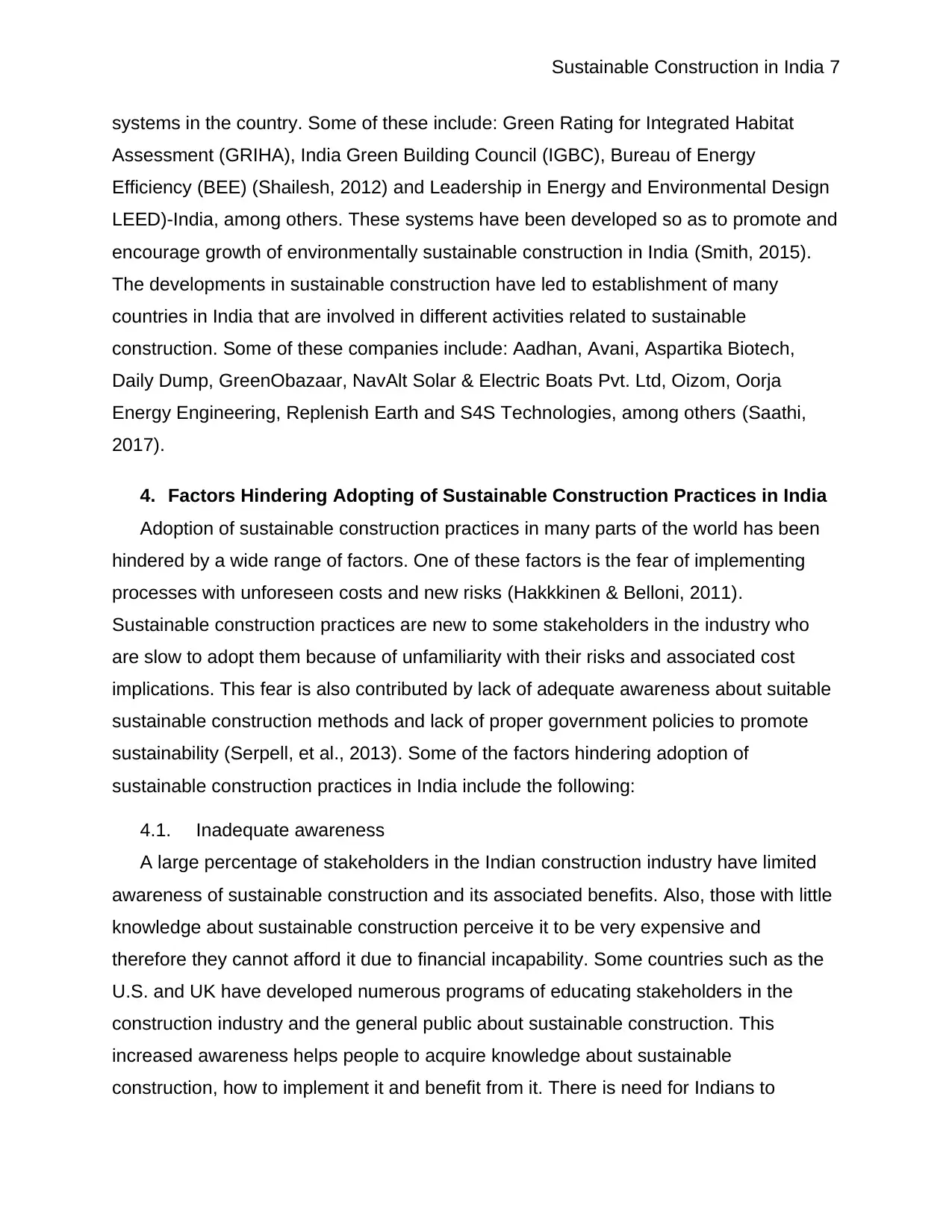
Sustainable Construction in India 7
systems in the country. Some of these include: Green Rating for Integrated Habitat
Assessment (GRIHA), India Green Building Council (IGBC), Bureau of Energy
Efficiency (BEE) (Shailesh, 2012) and Leadership in Energy and Environmental Design
LEED)-India, among others. These systems have been developed so as to promote and
encourage growth of environmentally sustainable construction in India (Smith, 2015).
The developments in sustainable construction have led to establishment of many
countries in India that are involved in different activities related to sustainable
construction. Some of these companies include: Aadhan, Avani, Aspartika Biotech,
Daily Dump, GreenObazaar, NavAlt Solar & Electric Boats Pvt. Ltd, Oizom, Oorja
Energy Engineering, Replenish Earth and S4S Technologies, among others (Saathi,
2017).
4. Factors Hindering Adopting of Sustainable Construction Practices in India
Adoption of sustainable construction practices in many parts of the world has been
hindered by a wide range of factors. One of these factors is the fear of implementing
processes with unforeseen costs and new risks (Hakkkinen & Belloni, 2011).
Sustainable construction practices are new to some stakeholders in the industry who
are slow to adopt them because of unfamiliarity with their risks and associated cost
implications. This fear is also contributed by lack of adequate awareness about suitable
sustainable construction methods and lack of proper government policies to promote
sustainability (Serpell, et al., 2013). Some of the factors hindering adoption of
sustainable construction practices in India include the following:
4.1. Inadequate awareness
A large percentage of stakeholders in the Indian construction industry have limited
awareness of sustainable construction and its associated benefits. Also, those with little
knowledge about sustainable construction perceive it to be very expensive and
therefore they cannot afford it due to financial incapability. Some countries such as the
U.S. and UK have developed numerous programs of educating stakeholders in the
construction industry and the general public about sustainable construction. This
increased awareness helps people to acquire knowledge about sustainable
construction, how to implement it and benefit from it. There is need for Indians to
systems in the country. Some of these include: Green Rating for Integrated Habitat
Assessment (GRIHA), India Green Building Council (IGBC), Bureau of Energy
Efficiency (BEE) (Shailesh, 2012) and Leadership in Energy and Environmental Design
LEED)-India, among others. These systems have been developed so as to promote and
encourage growth of environmentally sustainable construction in India (Smith, 2015).
The developments in sustainable construction have led to establishment of many
countries in India that are involved in different activities related to sustainable
construction. Some of these companies include: Aadhan, Avani, Aspartika Biotech,
Daily Dump, GreenObazaar, NavAlt Solar & Electric Boats Pvt. Ltd, Oizom, Oorja
Energy Engineering, Replenish Earth and S4S Technologies, among others (Saathi,
2017).
4. Factors Hindering Adopting of Sustainable Construction Practices in India
Adoption of sustainable construction practices in many parts of the world has been
hindered by a wide range of factors. One of these factors is the fear of implementing
processes with unforeseen costs and new risks (Hakkkinen & Belloni, 2011).
Sustainable construction practices are new to some stakeholders in the industry who
are slow to adopt them because of unfamiliarity with their risks and associated cost
implications. This fear is also contributed by lack of adequate awareness about suitable
sustainable construction methods and lack of proper government policies to promote
sustainability (Serpell, et al., 2013). Some of the factors hindering adoption of
sustainable construction practices in India include the following:
4.1. Inadequate awareness
A large percentage of stakeholders in the Indian construction industry have limited
awareness of sustainable construction and its associated benefits. Also, those with little
knowledge about sustainable construction perceive it to be very expensive and
therefore they cannot afford it due to financial incapability. Some countries such as the
U.S. and UK have developed numerous programs of educating stakeholders in the
construction industry and the general public about sustainable construction. This
increased awareness helps people to acquire knowledge about sustainable
construction, how to implement it and benefit from it. There is need for Indians to
Paraphrase This Document
Need a fresh take? Get an instant paraphrase of this document with our AI Paraphraser
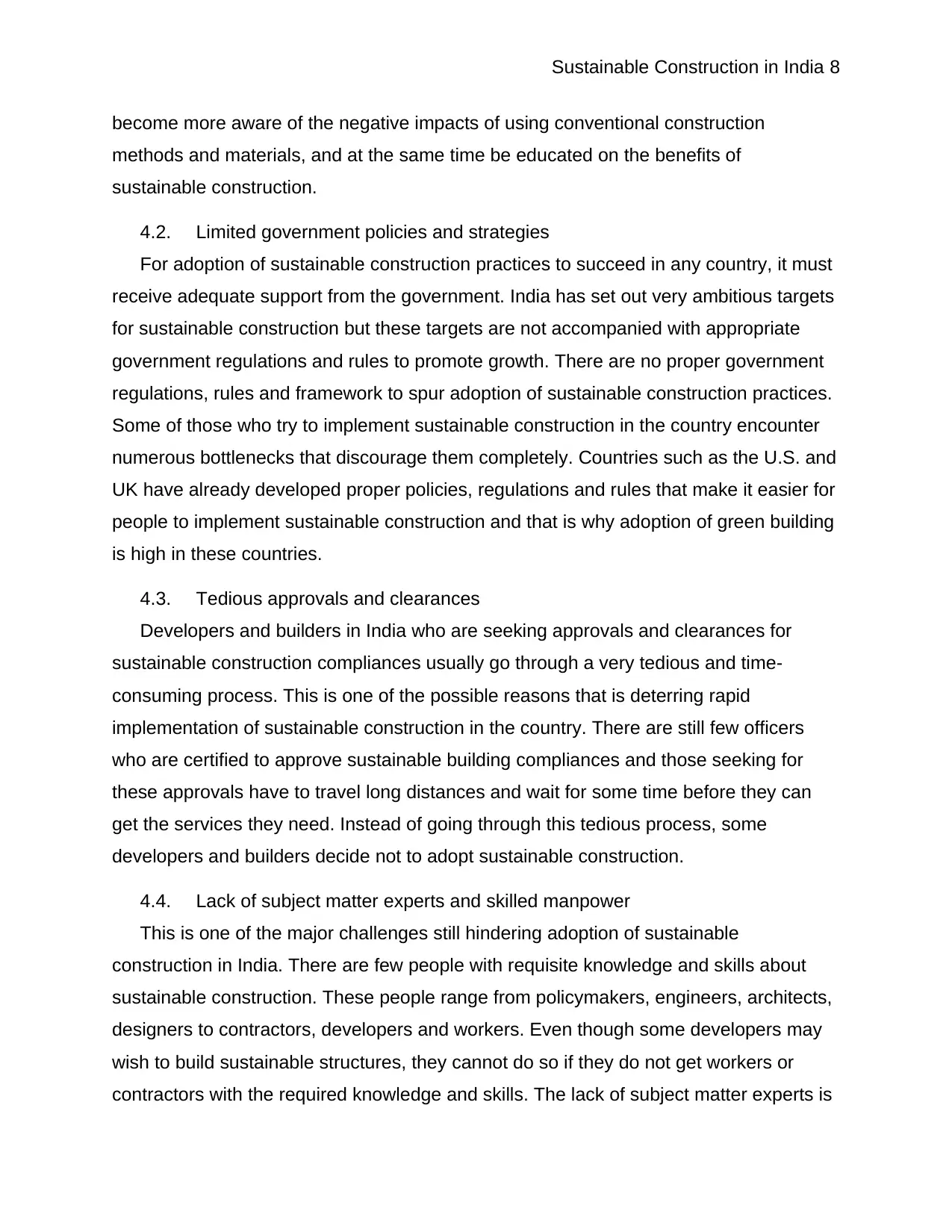
Sustainable Construction in India 8
become more aware of the negative impacts of using conventional construction
methods and materials, and at the same time be educated on the benefits of
sustainable construction.
4.2. Limited government policies and strategies
For adoption of sustainable construction practices to succeed in any country, it must
receive adequate support from the government. India has set out very ambitious targets
for sustainable construction but these targets are not accompanied with appropriate
government regulations and rules to promote growth. There are no proper government
regulations, rules and framework to spur adoption of sustainable construction practices.
Some of those who try to implement sustainable construction in the country encounter
numerous bottlenecks that discourage them completely. Countries such as the U.S. and
UK have already developed proper policies, regulations and rules that make it easier for
people to implement sustainable construction and that is why adoption of green building
is high in these countries.
4.3. Tedious approvals and clearances
Developers and builders in India who are seeking approvals and clearances for
sustainable construction compliances usually go through a very tedious and time-
consuming process. This is one of the possible reasons that is deterring rapid
implementation of sustainable construction in the country. There are still few officers
who are certified to approve sustainable building compliances and those seeking for
these approvals have to travel long distances and wait for some time before they can
get the services they need. Instead of going through this tedious process, some
developers and builders decide not to adopt sustainable construction.
4.4. Lack of subject matter experts and skilled manpower
This is one of the major challenges still hindering adoption of sustainable
construction in India. There are few people with requisite knowledge and skills about
sustainable construction. These people range from policymakers, engineers, architects,
designers to contractors, developers and workers. Even though some developers may
wish to build sustainable structures, they cannot do so if they do not get workers or
contractors with the required knowledge and skills. The lack of subject matter experts is
become more aware of the negative impacts of using conventional construction
methods and materials, and at the same time be educated on the benefits of
sustainable construction.
4.2. Limited government policies and strategies
For adoption of sustainable construction practices to succeed in any country, it must
receive adequate support from the government. India has set out very ambitious targets
for sustainable construction but these targets are not accompanied with appropriate
government regulations and rules to promote growth. There are no proper government
regulations, rules and framework to spur adoption of sustainable construction practices.
Some of those who try to implement sustainable construction in the country encounter
numerous bottlenecks that discourage them completely. Countries such as the U.S. and
UK have already developed proper policies, regulations and rules that make it easier for
people to implement sustainable construction and that is why adoption of green building
is high in these countries.
4.3. Tedious approvals and clearances
Developers and builders in India who are seeking approvals and clearances for
sustainable construction compliances usually go through a very tedious and time-
consuming process. This is one of the possible reasons that is deterring rapid
implementation of sustainable construction in the country. There are still few officers
who are certified to approve sustainable building compliances and those seeking for
these approvals have to travel long distances and wait for some time before they can
get the services they need. Instead of going through this tedious process, some
developers and builders decide not to adopt sustainable construction.
4.4. Lack of subject matter experts and skilled manpower
This is one of the major challenges still hindering adoption of sustainable
construction in India. There are few people with requisite knowledge and skills about
sustainable construction. These people range from policymakers, engineers, architects,
designers to contractors, developers and workers. Even though some developers may
wish to build sustainable structures, they cannot do so if they do not get workers or
contractors with the required knowledge and skills. The lack of subject matter experts is
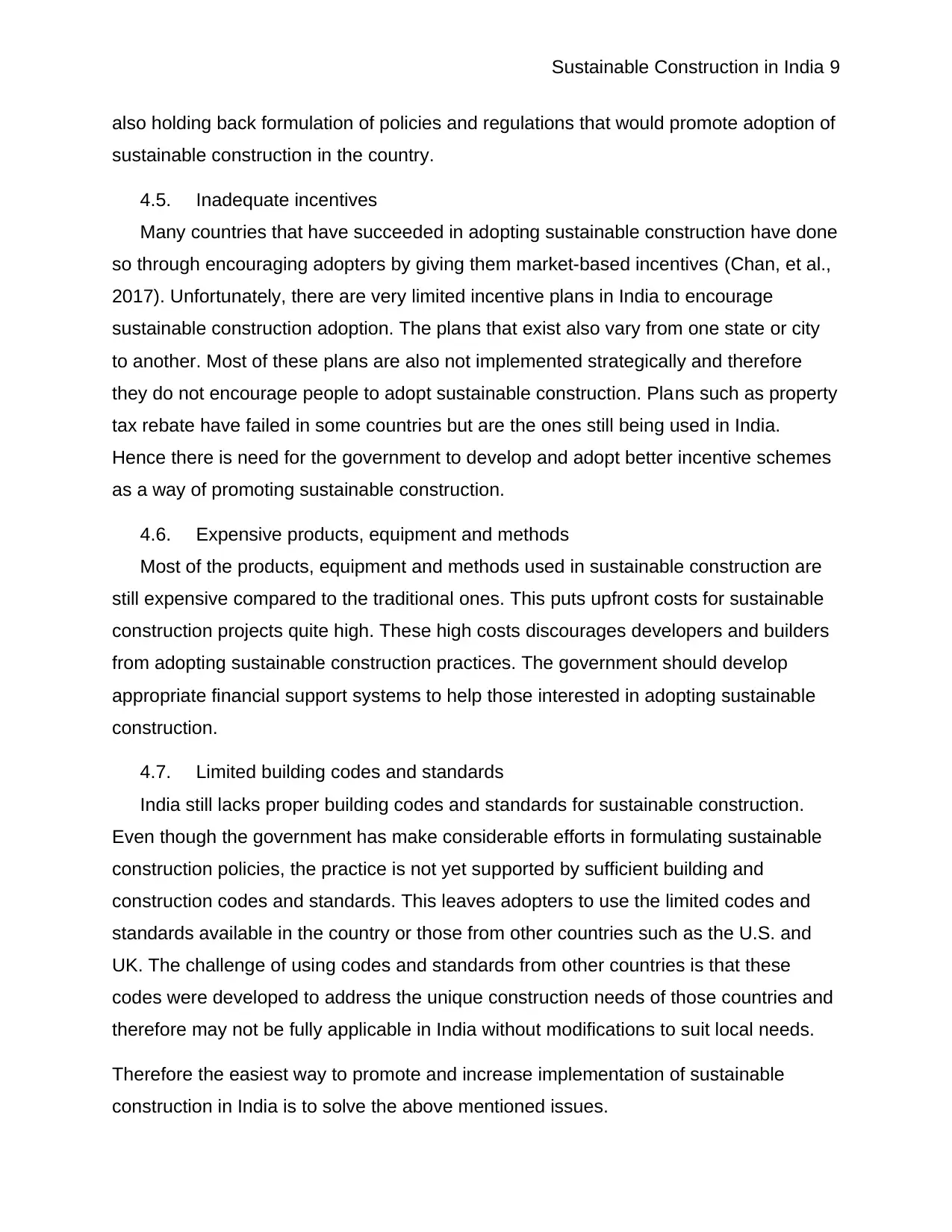
Sustainable Construction in India 9
also holding back formulation of policies and regulations that would promote adoption of
sustainable construction in the country.
4.5. Inadequate incentives
Many countries that have succeeded in adopting sustainable construction have done
so through encouraging adopters by giving them market-based incentives (Chan, et al.,
2017). Unfortunately, there are very limited incentive plans in India to encourage
sustainable construction adoption. The plans that exist also vary from one state or city
to another. Most of these plans are also not implemented strategically and therefore
they do not encourage people to adopt sustainable construction. Plans such as property
tax rebate have failed in some countries but are the ones still being used in India.
Hence there is need for the government to develop and adopt better incentive schemes
as a way of promoting sustainable construction.
4.6. Expensive products, equipment and methods
Most of the products, equipment and methods used in sustainable construction are
still expensive compared to the traditional ones. This puts upfront costs for sustainable
construction projects quite high. These high costs discourages developers and builders
from adopting sustainable construction practices. The government should develop
appropriate financial support systems to help those interested in adopting sustainable
construction.
4.7. Limited building codes and standards
India still lacks proper building codes and standards for sustainable construction.
Even though the government has make considerable efforts in formulating sustainable
construction policies, the practice is not yet supported by sufficient building and
construction codes and standards. This leaves adopters to use the limited codes and
standards available in the country or those from other countries such as the U.S. and
UK. The challenge of using codes and standards from other countries is that these
codes were developed to address the unique construction needs of those countries and
therefore may not be fully applicable in India without modifications to suit local needs.
Therefore the easiest way to promote and increase implementation of sustainable
construction in India is to solve the above mentioned issues.
also holding back formulation of policies and regulations that would promote adoption of
sustainable construction in the country.
4.5. Inadequate incentives
Many countries that have succeeded in adopting sustainable construction have done
so through encouraging adopters by giving them market-based incentives (Chan, et al.,
2017). Unfortunately, there are very limited incentive plans in India to encourage
sustainable construction adoption. The plans that exist also vary from one state or city
to another. Most of these plans are also not implemented strategically and therefore
they do not encourage people to adopt sustainable construction. Plans such as property
tax rebate have failed in some countries but are the ones still being used in India.
Hence there is need for the government to develop and adopt better incentive schemes
as a way of promoting sustainable construction.
4.6. Expensive products, equipment and methods
Most of the products, equipment and methods used in sustainable construction are
still expensive compared to the traditional ones. This puts upfront costs for sustainable
construction projects quite high. These high costs discourages developers and builders
from adopting sustainable construction practices. The government should develop
appropriate financial support systems to help those interested in adopting sustainable
construction.
4.7. Limited building codes and standards
India still lacks proper building codes and standards for sustainable construction.
Even though the government has make considerable efforts in formulating sustainable
construction policies, the practice is not yet supported by sufficient building and
construction codes and standards. This leaves adopters to use the limited codes and
standards available in the country or those from other countries such as the U.S. and
UK. The challenge of using codes and standards from other countries is that these
codes were developed to address the unique construction needs of those countries and
therefore may not be fully applicable in India without modifications to suit local needs.
Therefore the easiest way to promote and increase implementation of sustainable
construction in India is to solve the above mentioned issues.
⊘ This is a preview!⊘
Do you want full access?
Subscribe today to unlock all pages.

Trusted by 1+ million students worldwide
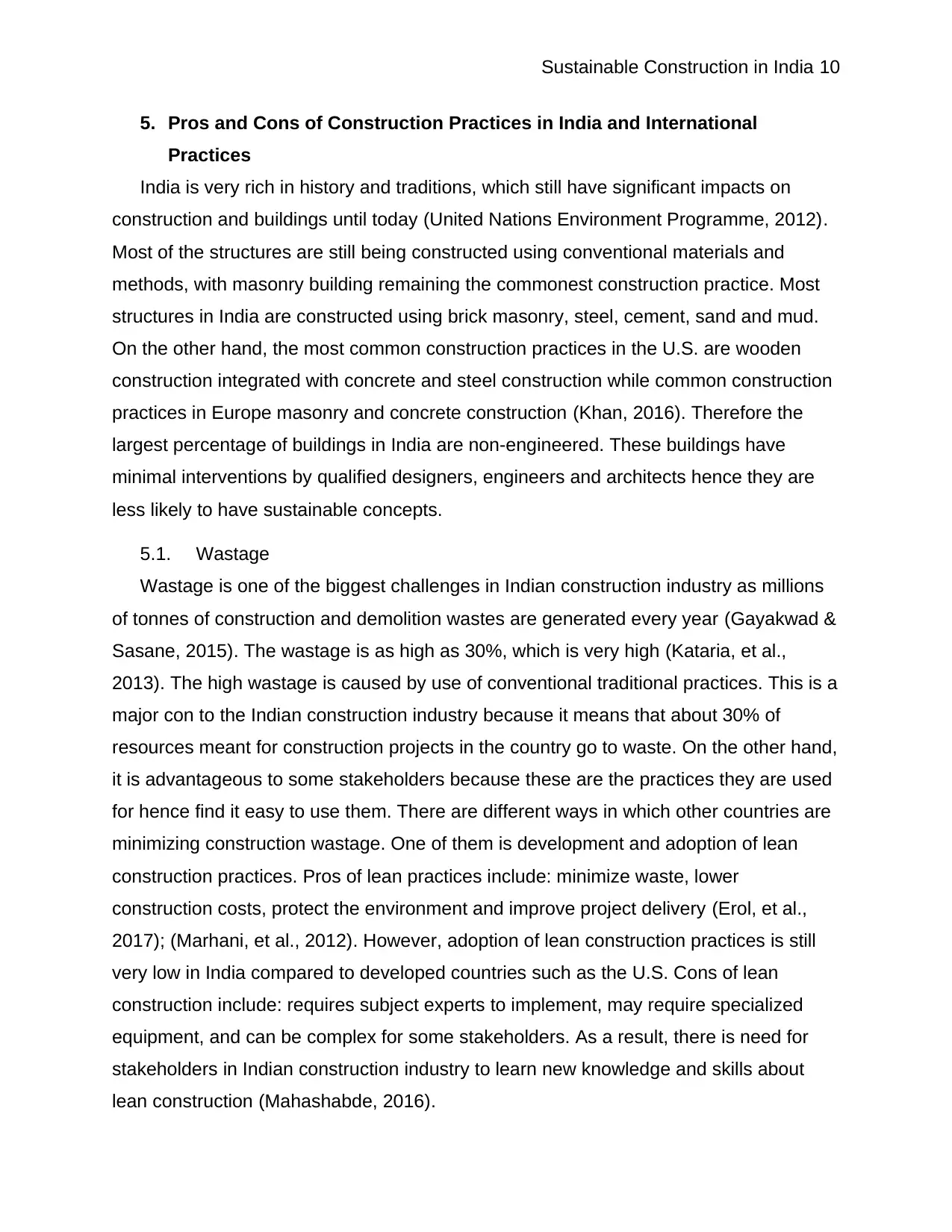
Sustainable Construction in India 10
5. Pros and Cons of Construction Practices in India and International
Practices
India is very rich in history and traditions, which still have significant impacts on
construction and buildings until today (United Nations Environment Programme, 2012).
Most of the structures are still being constructed using conventional materials and
methods, with masonry building remaining the commonest construction practice. Most
structures in India are constructed using brick masonry, steel, cement, sand and mud.
On the other hand, the most common construction practices in the U.S. are wooden
construction integrated with concrete and steel construction while common construction
practices in Europe masonry and concrete construction (Khan, 2016). Therefore the
largest percentage of buildings in India are non-engineered. These buildings have
minimal interventions by qualified designers, engineers and architects hence they are
less likely to have sustainable concepts.
5.1. Wastage
Wastage is one of the biggest challenges in Indian construction industry as millions
of tonnes of construction and demolition wastes are generated every year (Gayakwad &
Sasane, 2015). The wastage is as high as 30%, which is very high (Kataria, et al.,
2013). The high wastage is caused by use of conventional traditional practices. This is a
major con to the Indian construction industry because it means that about 30% of
resources meant for construction projects in the country go to waste. On the other hand,
it is advantageous to some stakeholders because these are the practices they are used
for hence find it easy to use them. There are different ways in which other countries are
minimizing construction wastage. One of them is development and adoption of lean
construction practices. Pros of lean practices include: minimize waste, lower
construction costs, protect the environment and improve project delivery (Erol, et al.,
2017); (Marhani, et al., 2012). However, adoption of lean construction practices is still
very low in India compared to developed countries such as the U.S. Cons of lean
construction include: requires subject experts to implement, may require specialized
equipment, and can be complex for some stakeholders. As a result, there is need for
stakeholders in Indian construction industry to learn new knowledge and skills about
lean construction (Mahashabde, 2016).
5. Pros and Cons of Construction Practices in India and International
Practices
India is very rich in history and traditions, which still have significant impacts on
construction and buildings until today (United Nations Environment Programme, 2012).
Most of the structures are still being constructed using conventional materials and
methods, with masonry building remaining the commonest construction practice. Most
structures in India are constructed using brick masonry, steel, cement, sand and mud.
On the other hand, the most common construction practices in the U.S. are wooden
construction integrated with concrete and steel construction while common construction
practices in Europe masonry and concrete construction (Khan, 2016). Therefore the
largest percentage of buildings in India are non-engineered. These buildings have
minimal interventions by qualified designers, engineers and architects hence they are
less likely to have sustainable concepts.
5.1. Wastage
Wastage is one of the biggest challenges in Indian construction industry as millions
of tonnes of construction and demolition wastes are generated every year (Gayakwad &
Sasane, 2015). The wastage is as high as 30%, which is very high (Kataria, et al.,
2013). The high wastage is caused by use of conventional traditional practices. This is a
major con to the Indian construction industry because it means that about 30% of
resources meant for construction projects in the country go to waste. On the other hand,
it is advantageous to some stakeholders because these are the practices they are used
for hence find it easy to use them. There are different ways in which other countries are
minimizing construction wastage. One of them is development and adoption of lean
construction practices. Pros of lean practices include: minimize waste, lower
construction costs, protect the environment and improve project delivery (Erol, et al.,
2017); (Marhani, et al., 2012). However, adoption of lean construction practices is still
very low in India compared to developed countries such as the U.S. Cons of lean
construction include: requires subject experts to implement, may require specialized
equipment, and can be complex for some stakeholders. As a result, there is need for
stakeholders in Indian construction industry to learn new knowledge and skills about
lean construction (Mahashabde, 2016).
Paraphrase This Document
Need a fresh take? Get an instant paraphrase of this document with our AI Paraphraser
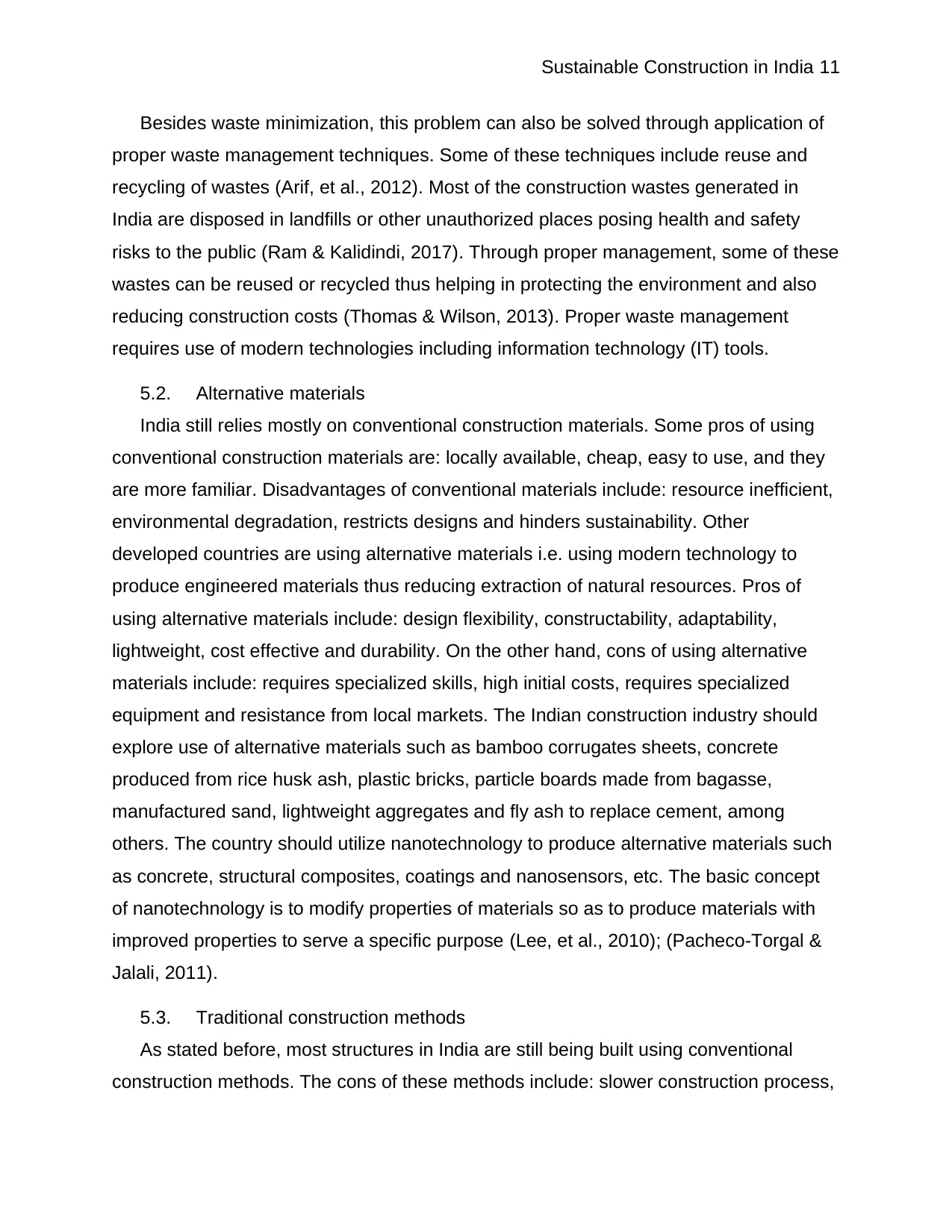
Sustainable Construction in India 11
Besides waste minimization, this problem can also be solved through application of
proper waste management techniques. Some of these techniques include reuse and
recycling of wastes (Arif, et al., 2012). Most of the construction wastes generated in
India are disposed in landfills or other unauthorized places posing health and safety
risks to the public (Ram & Kalidindi, 2017). Through proper management, some of these
wastes can be reused or recycled thus helping in protecting the environment and also
reducing construction costs (Thomas & Wilson, 2013). Proper waste management
requires use of modern technologies including information technology (IT) tools.
5.2. Alternative materials
India still relies mostly on conventional construction materials. Some pros of using
conventional construction materials are: locally available, cheap, easy to use, and they
are more familiar. Disadvantages of conventional materials include: resource inefficient,
environmental degradation, restricts designs and hinders sustainability. Other
developed countries are using alternative materials i.e. using modern technology to
produce engineered materials thus reducing extraction of natural resources. Pros of
using alternative materials include: design flexibility, constructability, adaptability,
lightweight, cost effective and durability. On the other hand, cons of using alternative
materials include: requires specialized skills, high initial costs, requires specialized
equipment and resistance from local markets. The Indian construction industry should
explore use of alternative materials such as bamboo corrugates sheets, concrete
produced from rice husk ash, plastic bricks, particle boards made from bagasse,
manufactured sand, lightweight aggregates and fly ash to replace cement, among
others. The country should utilize nanotechnology to produce alternative materials such
as concrete, structural composites, coatings and nanosensors, etc. The basic concept
of nanotechnology is to modify properties of materials so as to produce materials with
improved properties to serve a specific purpose (Lee, et al., 2010); (Pacheco-Torgal &
Jalali, 2011).
5.3. Traditional construction methods
As stated before, most structures in India are still being built using conventional
construction methods. The cons of these methods include: slower construction process,
Besides waste minimization, this problem can also be solved through application of
proper waste management techniques. Some of these techniques include reuse and
recycling of wastes (Arif, et al., 2012). Most of the construction wastes generated in
India are disposed in landfills or other unauthorized places posing health and safety
risks to the public (Ram & Kalidindi, 2017). Through proper management, some of these
wastes can be reused or recycled thus helping in protecting the environment and also
reducing construction costs (Thomas & Wilson, 2013). Proper waste management
requires use of modern technologies including information technology (IT) tools.
5.2. Alternative materials
India still relies mostly on conventional construction materials. Some pros of using
conventional construction materials are: locally available, cheap, easy to use, and they
are more familiar. Disadvantages of conventional materials include: resource inefficient,
environmental degradation, restricts designs and hinders sustainability. Other
developed countries are using alternative materials i.e. using modern technology to
produce engineered materials thus reducing extraction of natural resources. Pros of
using alternative materials include: design flexibility, constructability, adaptability,
lightweight, cost effective and durability. On the other hand, cons of using alternative
materials include: requires specialized skills, high initial costs, requires specialized
equipment and resistance from local markets. The Indian construction industry should
explore use of alternative materials such as bamboo corrugates sheets, concrete
produced from rice husk ash, plastic bricks, particle boards made from bagasse,
manufactured sand, lightweight aggregates and fly ash to replace cement, among
others. The country should utilize nanotechnology to produce alternative materials such
as concrete, structural composites, coatings and nanosensors, etc. The basic concept
of nanotechnology is to modify properties of materials so as to produce materials with
improved properties to serve a specific purpose (Lee, et al., 2010); (Pacheco-Torgal &
Jalali, 2011).
5.3. Traditional construction methods
As stated before, most structures in India are still being built using conventional
construction methods. The cons of these methods include: slower construction process,
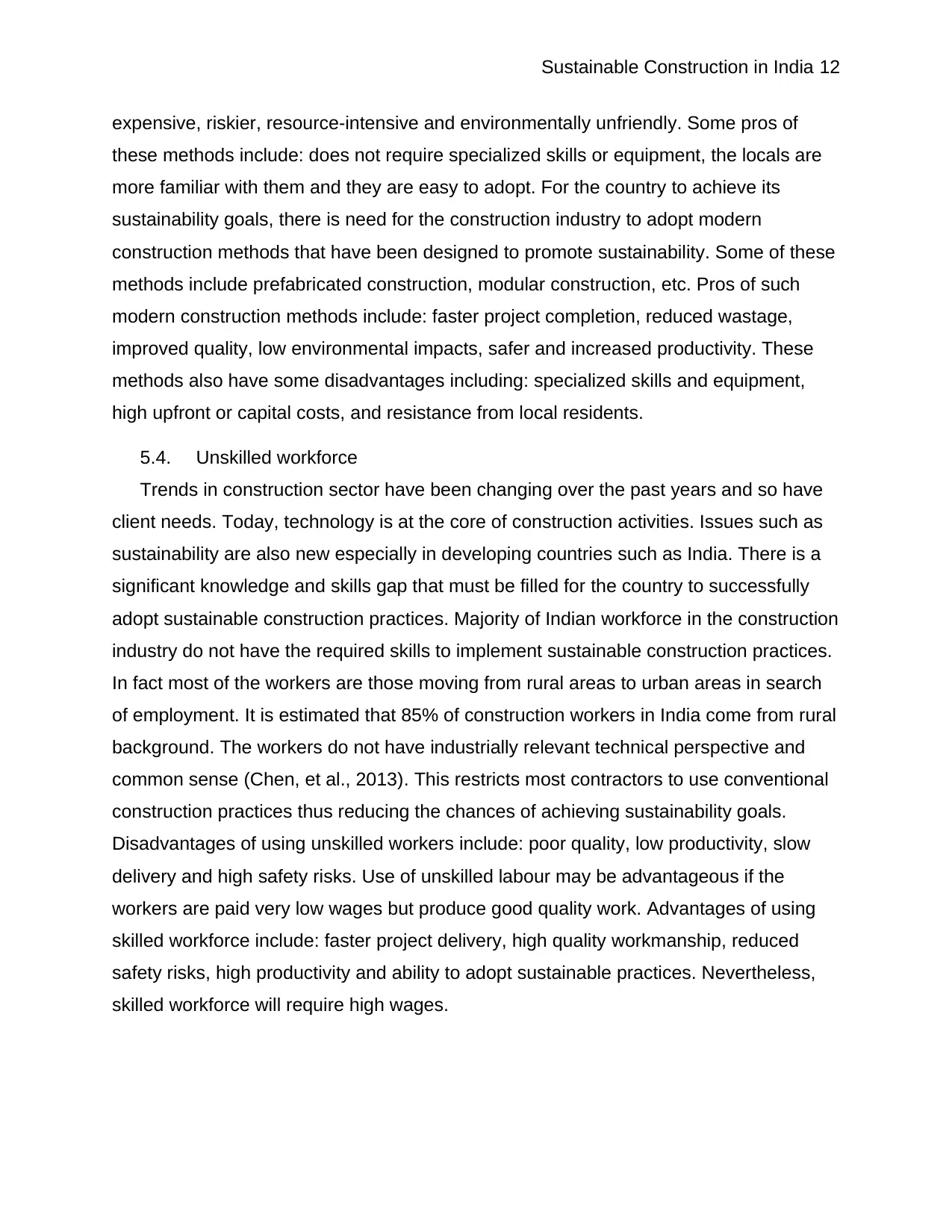
Sustainable Construction in India 12
expensive, riskier, resource-intensive and environmentally unfriendly. Some pros of
these methods include: does not require specialized skills or equipment, the locals are
more familiar with them and they are easy to adopt. For the country to achieve its
sustainability goals, there is need for the construction industry to adopt modern
construction methods that have been designed to promote sustainability. Some of these
methods include prefabricated construction, modular construction, etc. Pros of such
modern construction methods include: faster project completion, reduced wastage,
improved quality, low environmental impacts, safer and increased productivity. These
methods also have some disadvantages including: specialized skills and equipment,
high upfront or capital costs, and resistance from local residents.
5.4. Unskilled workforce
Trends in construction sector have been changing over the past years and so have
client needs. Today, technology is at the core of construction activities. Issues such as
sustainability are also new especially in developing countries such as India. There is a
significant knowledge and skills gap that must be filled for the country to successfully
adopt sustainable construction practices. Majority of Indian workforce in the construction
industry do not have the required skills to implement sustainable construction practices.
In fact most of the workers are those moving from rural areas to urban areas in search
of employment. It is estimated that 85% of construction workers in India come from rural
background. The workers do not have industrially relevant technical perspective and
common sense (Chen, et al., 2013). This restricts most contractors to use conventional
construction practices thus reducing the chances of achieving sustainability goals.
Disadvantages of using unskilled workers include: poor quality, low productivity, slow
delivery and high safety risks. Use of unskilled labour may be advantageous if the
workers are paid very low wages but produce good quality work. Advantages of using
skilled workforce include: faster project delivery, high quality workmanship, reduced
safety risks, high productivity and ability to adopt sustainable practices. Nevertheless,
skilled workforce will require high wages.
expensive, riskier, resource-intensive and environmentally unfriendly. Some pros of
these methods include: does not require specialized skills or equipment, the locals are
more familiar with them and they are easy to adopt. For the country to achieve its
sustainability goals, there is need for the construction industry to adopt modern
construction methods that have been designed to promote sustainability. Some of these
methods include prefabricated construction, modular construction, etc. Pros of such
modern construction methods include: faster project completion, reduced wastage,
improved quality, low environmental impacts, safer and increased productivity. These
methods also have some disadvantages including: specialized skills and equipment,
high upfront or capital costs, and resistance from local residents.
5.4. Unskilled workforce
Trends in construction sector have been changing over the past years and so have
client needs. Today, technology is at the core of construction activities. Issues such as
sustainability are also new especially in developing countries such as India. There is a
significant knowledge and skills gap that must be filled for the country to successfully
adopt sustainable construction practices. Majority of Indian workforce in the construction
industry do not have the required skills to implement sustainable construction practices.
In fact most of the workers are those moving from rural areas to urban areas in search
of employment. It is estimated that 85% of construction workers in India come from rural
background. The workers do not have industrially relevant technical perspective and
common sense (Chen, et al., 2013). This restricts most contractors to use conventional
construction practices thus reducing the chances of achieving sustainability goals.
Disadvantages of using unskilled workers include: poor quality, low productivity, slow
delivery and high safety risks. Use of unskilled labour may be advantageous if the
workers are paid very low wages but produce good quality work. Advantages of using
skilled workforce include: faster project delivery, high quality workmanship, reduced
safety risks, high productivity and ability to adopt sustainable practices. Nevertheless,
skilled workforce will require high wages.
⊘ This is a preview!⊘
Do you want full access?
Subscribe today to unlock all pages.

Trusted by 1+ million students worldwide
1 out of 25
Related Documents
Your All-in-One AI-Powered Toolkit for Academic Success.
+13062052269
info@desklib.com
Available 24*7 on WhatsApp / Email
![[object Object]](/_next/static/media/star-bottom.7253800d.svg)
Unlock your academic potential
Copyright © 2020–2025 A2Z Services. All Rights Reserved. Developed and managed by ZUCOL.




